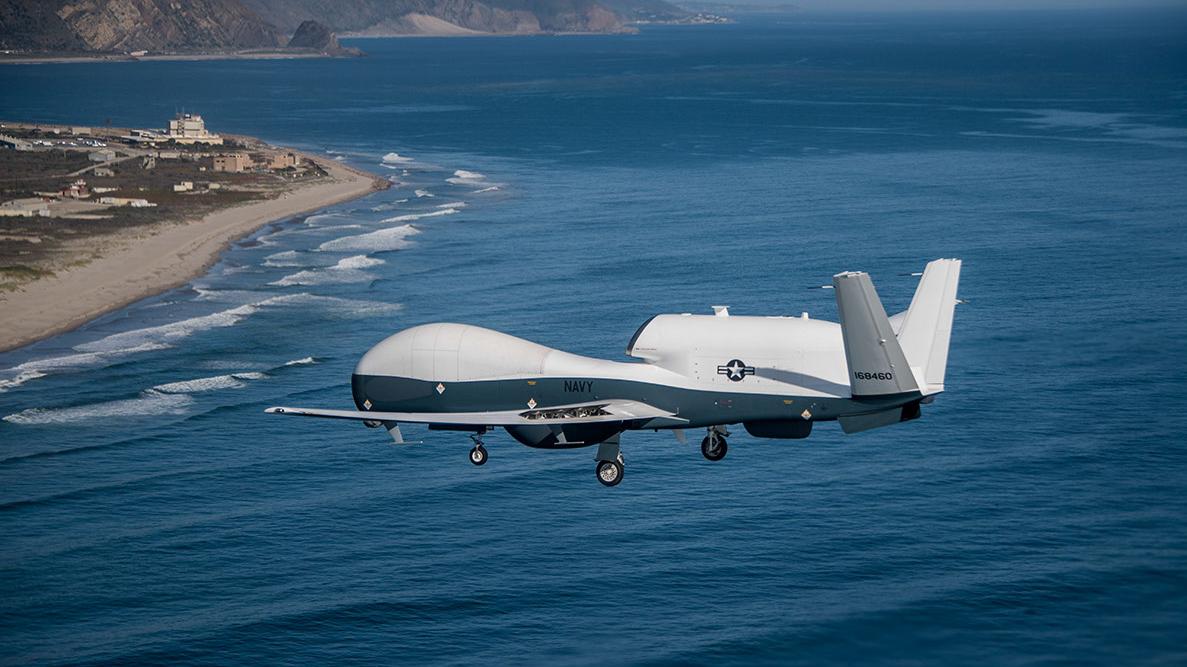In a major development marking a stride in maritime surveillance capabilities, the US Navy has initiated operations of its Northrop Grumman MQ-4C Triton Broad Area Maritime Surveillance (BAMS) in the European theatre.
According to online flight tracking services, the UAV departed Naval Air Station (NAS) Sigonella in Sicily on April 17 for its first sortie.
The confirmation of the deployment comes approximately two weeks after the US Navy disclosed in late March that the initial MQ-4C Triton had arrived in the Sixth Fleet area of operations.
The Sixth Fleet, associated with US Naval Forces Europe-Africa (NAVEUR-NAVAF), manages naval activities in and around Europe and Africa and oversees strategic commands within the region.
Flight tracking data revealed that the MQ-4C Triton conducted its mission in the Mediterranean, specifically off the coast of Libya. The unmanned aircraft was observed orbiting in international waters between Libya and Crete, potentially monitoring activities in eastern Libya.
US Navy MQ-4C Triton Maritime Reconnaissance Drone as "TRITON19" out of Sigonella NAS is out in the Mediterranean Sea.
First deployment in the area 👀 (reg 169659) pic.twitter.com/CopqX9oWf9
— MenchOsint (@MenchOsint) April 17, 2024
Speculation suggested that the mission’s focus might have been on monitoring shipments of weapons reportedly conducted by Russia from the Syrian port of Tartus to Tobruk in eastern Libya. However, so far, the US Navy has not released an official statement regarding the specifics of the mission.
The MQ-4C Triton deployed to NAS Sigonella arrived on March 30, with preparations for its arrival including a ceremony held by Unmanned Patrol Squadron 19 (VUP-19) “Big Red” on March 2 to commemorate the deployment and the opening of a new Triton hangar at the base.
VUP-19, based at Naval Air Station Jacksonville in Florida, is the Navy’s sole operational MQ-4C squadron, with a detachment also located at Point Mugu in California. Plans, however, are in place to establish a second unit, VUP-11, in the 2026 Fiscal Year.
The deployment of the MQ-4C Triton to Sigonella holds strategic significance, as the base has long served as a crucial staging point for US military operations in the region. NAS Sigonella is already home to Air Force RQ-4As and NATO RQ-4Ds, bolstering surveillance capabilities in the area.
The introduction of the MQ-4C Triton has added another layer to the surveillance efforts, particularly in light of increased activity in the Black Sea region since Russia invaded Ukraine in 2022. The deployment underscores the US Navy’s efforts to enhance its intelligence, surveillance, and reconnaissance capabilities in Europe and Africa.
The installation’s strategic positioning facilitates the deployment and response of US, allied, and partner nation forces as necessary, thereby guaranteeing security and stability across Europe, Africa, and Central Command.
Northrop Grumman MQ-4C Triton
The MQ-4C Triton, a derivative of the RQ-4 Global Hawk high-altitude long-endurance drone, is a crucial asset for maritime surveillance operations. Developed by Northrop Grumman, the Triton has been optimized for persistent over-water missions and showcases enhanced capabilities tailored for naval operations.
Distinguishing itself from its predecessor, the RQ-4A, the MQ-4C Triton boasts a reinforced fuselage and wings, along with advanced features to mitigate ice build-up and improve resilience against lightning strikes.
These enhancements enable the Triton to descend to lower altitudes for closer examination of surface targets, augmenting its surveillance capabilities.
Equipped with a sophisticated sensor suite, the MQ-4C Triton originally featured an active electronically scanned radar, electro-optical and infrared video cameras, and electronic support measure systems.
However, recent advances have seen Northrop Grumman delivering upgraded Tritons to the Navy in a Multi-Intelligence (Multi-Int) configuration. This configuration integrates additional electronic and signals intelligence (ELINT/SIGINT) capabilities, augmenting the Triton’s versatility and efficacy in surveillance operations.

Moreover, the US Navy’s extensive experience with older Global Hawk variants has significantly influenced the development and operational tactics of the MQ-4C Triton.
Operating Block 10 RQ-4As from Al Dhafra Air Base in the United Arab Emirates (UAE) between 2009 and 2022, the US Navy gleaned invaluable insights into maritime surveillance, contributing to the refinement of Triton operations.
Additionally, Triton operations are integrated with Navy P-8A Poseidon maritime patrol and surveillance aircraft, as well as aircraft carrier strike groups.
This collaborative approach enhances maritime domain awareness and enables synchronized operations across naval assets, bolstering the US Navy’s ability to monitor and respond effectively to maritime threats.
Beyond its deployment with the US Navy, the MQ-4C Triton garners international attention. Australia is in the process of acquiring this high-altitude, long-endurance unmanned aerial vehicle. Additionally, variants of the Global Hawk platform are operational with South Korea, Japan, the US Air Force, and NATO alliance members.
- Contact the author at ashishmichel(at)gmail.com
- Follow EurAsian Times on Google News




